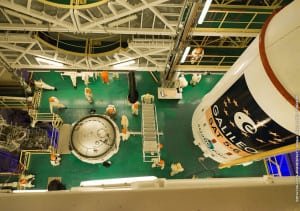Latest News
[Via Satellite 08-21-2014] The European Space Agency has not yet identified the cause of several anomalies that have affected some of the first Galileo satellites. Three of the first four in orbit have experienced irregularities that officials said are so far unrelated. ESA is taking steps to prevent further troubles with the European Global Navigation Satellite System (GNSS) but has not slowed the pace of the program, which is set to have 30 satellites in orbit by 2020.
“We backed off 1.5 decibels of power on all four spacecraft about a month ago,” Javier Benedicto, Galileo program manager at ESA said on an Aug. 20 conference call. “This was done as a precautionary measure.”
One of the four satellites, FM 1, experienced a drop in power that was traced back to a failed Solid State Power Amplifier (SSPA). Two others however, FM 2 and FM4, have also experienced reductions in power that have yet to be explained. Benedicto said there could be a common cause between FM 2 and FM 4, but this remains uncertain.
In the months since the latest anomaly, ESA has undertaken 40 different studies including telemetry analysis, tilting the FM 4 satellite to evaluate radiation patterns, and even obtaining equipment samples from equipment manufacturers.
Astrium, now Airbus Defence and Space, and subcontractor Thales Alenia Space Italy are the manufacturers for the Galileo IOV satellites. Tests to date have confirmed a “permanent degradation” on frequency bands E5 and E6. The satellites transmit on three frequency bands, leaving E1 the only band fully intact.
ESA has set an aggressive schedule to orbit 27 operational satellites and three in-orbit spares. The first two Full Operational Capability (FOC) satellites are scheduled to launch soon, pending delays from unfavorable weather conditions at Kourou spaceport. Arianespace is launching satellites five and six, known as “Doresa” and “Milena,” on a Soyuz rocket into Medium Earth Orbit (MEO). The agency is confident that new satellites should not experience the same setbacks as their predecessors.
“We have investigated the commonalities with the design of the satellites we are ready to launch … and we have concluded that there is no common mode of failure between that possible failure, that possible root cause in [In-Orbit Validation] IOV, and the FOC design,” said Benedicto.
Benedicto said there has been no degradation in mission performance, as a margin was included in the program for situations such as this. Didier Faivre, ESA’s director of navigation programs, said ESA has committed to five Soyuz rockets and three Ariane 5s to launch the 22 Galileo satellites over the next two years. The agency anticipates launching four satellites this year — two in the near future and two more by the year’s end. Faivre said 2015 should see six to eight satellite launched, depending on the cadence of manufacturing and Arianespace’s launch schedule. The five Soyuz rockets would launch two Galileo satellites each, while the three Ariane 5s would launch the remaining 12. The contract is worth more than $660 million.
The prearranged launches and current schedule set the pace for the majority of the constellation. There is little room for changes, should more anomalies show up, and ESA said it has not yet decided on future procurement. Should the spacecraft work well, then changes are unlikely, but more failures would mean ESA would have to take a second look at the satellite’s design.
“We are in line with the mission requirement and the question will be how do we manage the space similar to the ones we have launched, or do we have to change a few things?” said Benedicto.
Decisions on future procurement will come next year, he said. The European Commission (EC) has allocated the necessary funding already for all 30 satellites. An early service date has not been set, but Faivre said that with six spacecraft in orbit, at least one will be visible from nearly any point on the globe. The in-orbit testing period for each satellite is 73 days, at which point it is deemed operational.
Get the latest Via Satellite news!
Subscribe Now